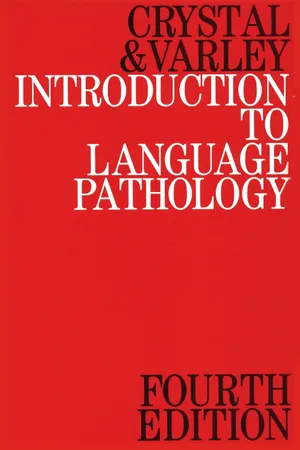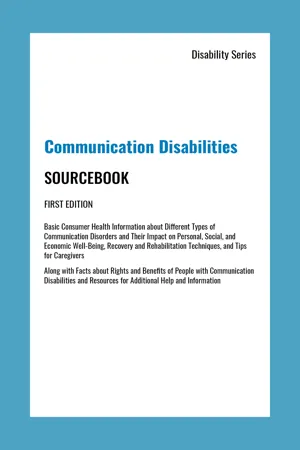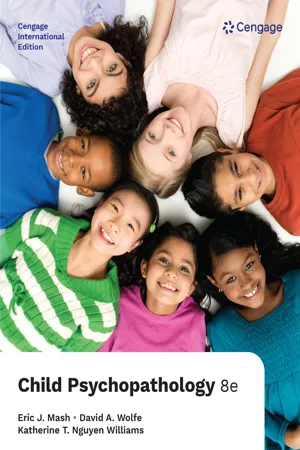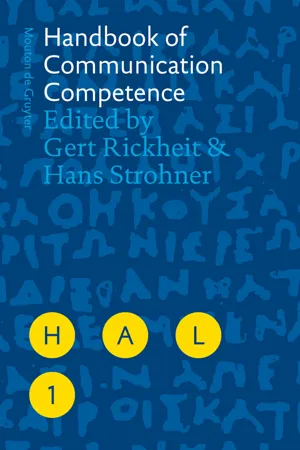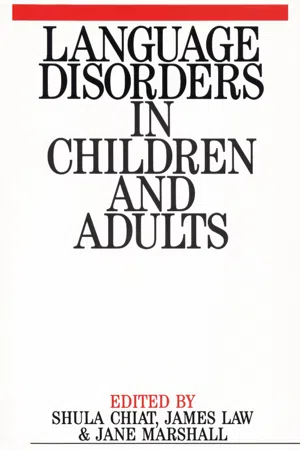Psychology
Language Disorders
Language disorders refer to difficulties in understanding and using spoken or written language. These disorders can affect various aspects of language, including grammar, vocabulary, and comprehension. They can be caused by neurological conditions, developmental delays, or environmental factors, and may impact an individual's ability to communicate effectively.
Written by Perlego with AI-assistance
Related key terms
1 of 5
9 Key excerpts on "Language Disorders"
- eBook - ePub
- Robin L. Hansen, Sally J. Rogers, Robin L. Hansen, Sally J. Rogers(Authors)
- 2012(Publication Date)
- American Psychiatric Association Publishing(Publisher)
PEECH AND LANGUAGE DISORDERS IN CHILDHOOD A Neurodevelopmental Perspective Ann M. Mastergeorge, Ph.D.Signs, Symptoms, and Developmental Course
In DSM-5, which is expected to replace DSM-IV-TR (American Psychiatric Association 2000 ) in 2013, speech and Language Disorders will fall under the heading of neurodevelopmental disorders, and the term Language Disorders will be used to describe language behaviors that are different from those expected for a child’s chronological age. The definition of Language Disorders by the American Speech-Language-Hearing Association is influenced primarily by Bloom and Lahey’s (1978) conceptual model of the structure of language and the domains that are affected if this structure is disrupted. A language disorder may involve one or more of the following: 1) the form of language (phonology, morphology, syntax), 2) the content of language (semantics), 3) the function or use of language in social communication (pragmatics). The various patterns emphasize that Language Disorders encompass many different kinds of disruption in the integration of content, form, and use. The term describes the conditions of children who have difficulty learning the form of language (a disruption of form), children who can talk easily and readily but who have little meaning in their communication (a disruption of content), and children who use forms to communicate ideas but not in the conventional manner (a distortion of the interactions among content, form, and use). In sum, a language disorder is an impairment in the ability to 1) receive and/or process a symbol system, 2) represent concepts or symbol systems, and/or 3) transmit or use symbol systems.Language Disorders are heterogeneous, vary in levels of severity, and are generally categorized by the type of exhibited symptoms. Children with Language Disorders typically share four common symptoms. First, children with language delays almost always show a deficiency in the quantity of language learned - eBook - ePub
- David Crystal, Rosemary Varley(Authors)
- 2013(Publication Date)
- Wiley(Publisher)
An important characteristic of Language Disorders is that their effects may appear at different points in the communication chain, and in any of the modalities of language use. The disorder may affect both language encoding and decoding – that is, the patient could have difficulties both in formulating linguistic messages and in understanding them. It is possible, however, that language encoding alone may be affected, with the ability to understand language being relatively normal; and, more rarely, that language decoding may be affected, with the ability to produce language appearing normal. In both cases, there needs to be careful assessment by the language pathologist, because comprehension disorders may go unnoticed – the patient perhaps using other sources of information to decode messages, such as the contextual or the non-verbal (see p. 82). In addition to affecting performance across input and output, Language Disorders may disrupt performances across both auditory and visual channels of language use – that is, speech/listening and reading/writing. Thus a child with a language disorder may have difficulties in creating grammatical sentences in speech, and problems of a similar order may also be observed in writing. Pre-school children with Language Disorders may also go on to have difficulties in learning to read and write.Different degrees of involvement of the four channels of language use result in one patient potentially being very different from another. Language disorder is not a homogenous category. Not only are there differences in performance across modalities; patients may also differ in the type of difficulty they have within modalities, such as when formulating a spoken message. One patient may have particular difficulty in producing a grammatical sentence, whereas another may have problems in finding the appropriate words for use in a sentence. The language pathologist might describe the first patient’s difficulty as one of grammatical encoding, and the second as one of semantic or lexical encoding. Any of the levels of language organization that were identified in Chapter 2 – grammar, semantics, phonology and pragmatics – may be affected, and to varying degrees. The language pathologist must therefore have considerable skill in performing linguistic analyses in order to be able to pinpoint areas of deficit in the patient’s linguistic knowledge and performance. During the 1970s, several important developments in the analytical study of language disability took place within the range of disciplines categorized as ‘behavioural’ (p. 30). The application of ideas from the fields of psychology and linguistics have, as a result, shaped present-day perceptions of language disability. - eBook - ePub
The SAGE Handbook of Clinical Neuropsychology
Clinical Neuropsychological Disorders
- Gregory J. Boyle, Yaakov Stern, Dan J. Stein, Barbara J. Sahakian, Charles J. Golden, Tatia Mei-Chun Lee, Shen-Hsing Annabel Chen, Gregory J. Boyle, Yaakov Stern, Dan J. Stein, Barbara J. Sahakian, Charles J. Golden, Tatia Mei-Chun Lee, Shen-Hsing Annabel Chen, Author(Authors)
- 2023(Publication Date)
- SAGE Publications Ltd(Publisher)
(2017) have important implications for ensuring that definitions are applied consistently across the field, given that the lack of consensus in terminology to date has impeded diagnosis and treatment of Language Disorders, and limited relevant research. In this chapter, we refer to the constellation of significant language-related challenges as language disorder. This label, mirroring that of the DSM-5, is the terminology to which a clinical neuropsychologist may have the most exposure in undertaking diagnostic assessment. Prevalence Estimates of language disorder vary somewhat depending on methodological differences, including diverse labelling practices and group membership inclusion criteria. Language disorder is widely regarded as a fairly common condition associated with significant functional impairment, such that the child's academic performance, social interactions, or effective communication is impacted (Bishop et al., 2017). This functional impairment can continue into adulthood (Whitehouse et al., 2009). Prevalence typically hovers at 7 percent in the general population, with males more often affected than females at a ratio of about 4:3 (Norbury et al., 2016). Language disorder also appears to be heritable to many cases (Conti-Ramsden et al., 2007). Several genes implicated in memory as well as the motor production of speech have been associated with language disorder risk. Other genetic factors as well as environmental influences are posited to impact the risk and expression of clinical language impairments, though less is known about what these factors are and how they interact with identified risk genes (Newbury et al., 2010). Developmental Trajectories Language production and acquisition follow a typical developmental trajectory. Toddlerhood encompasses a period of rapid cognitive, language and socio-emotional development (National Research Council, 2000) - eBook - ePub
- Bill Gillham(Author)
- 2022(Publication Date)
- Routledge(Publisher)
CHAPTER 2 Disorders of Language and Communication DOI: 10.4324/9781003261964-2 BILL GILLHAMThe two milestones most eagerly awaited by the parents of a young child are the first independent steps and the first independent words. Both achievements, if they occur at around the normal time, are incontrovertible evidence that several interrelated systems of the body and brain are functioning efficiently. Of the two achievements, independent language use is the more complex neurologically and is of more direct significance for normal psychological development. It marks emerging intelligence and the development of relationships with other people.It is not surprising, therefore, that the commonest reason for a preschool child to be brought to a psychological or paediatric clinic is language delay. The great majority of such children will go on to develop language normally, without special help; they will have had a simple delay which caused temporary concern but was, self-evidently, of no particular significance. But in a minority the delay will be more enduring and may prove to be symptomatic of other conditions such as mental handicap or hearing impairment. For these reasons all language delay has to be taken seriously since it is only by careful investigation and the monitoring of progress that those children who need special attention can be identified.What is Language?
Language is most simply described as a system of symbols which we can use to represent ideas, information, wishes, intentions and the like. That much is obvious. When we use the term ‘language’ we are most commonly referring to speech — the expressive dimension. Less conspicuous, but equally important, our understanding of language (comprehension) is another part of the process. More covertly we also use language as an internal or associative - eBook - PDF
- Angela L. Williams(Author)
- 2020(Publication Date)
- Omnigraphics(Publisher)
• Fluency. A fluency disorder is one that interferes with the smoothness, continuity, and typical rate of speech. It can include the repetition of sounds or entire words, broken words, gaps in speech, and prolongation of certain sounds. The most common fluency disorder is stuttering, which typically begins in childhood and, in some cases, may last a lifetime. Language Disorders A person with a language disorder has difficulty understanding what is being said by others, finding the right words to communicate clearly, or both. There are three primary types of Language Disorders: • Receptive Language Disorders. Individuals with receptive Language Disorders have difficulty understanding, retaining, and processing spoken language. Although symptoms vary considerably, they can include a person appearing not to listen, an inability to comprehend complex sentences, difficulty following conversations, and an inability to follow instructions. • Expressive Language Disorders. Those with expressive Language Disorders have difficulty putting words and sentences together verbally or in writing in a cohesive 20 | Communication Disabilities, First Edition and culturally appropriate manner. The condition is characterized by limited vocabulary, difficulty recalling words, poor grammar, and the inability to put sentences together to tell a coherent story. • Mixed Language Disorders. A mixed receptive-expressive language disorder is one in which an individual has trouble both understanding others and expressing her- or himself effectively. The outward characteristics of this condition are essentially the same as those of expressive language disorder but may also include inappropriate responses to communication or an inability to follow instructions. DIAGNOSIS Sometimes speech and Language Disorders are caused by conditions such as hearing loss, brain injury, neurological problems, or physical issues in the mouth or throat. - eBook - PDF
- Eric Mash, Eric Mash, David Wolfe, Katherine Nguyen Williams(Authors)
- 2023(Publication Date)
- Cengage Learning EMEA(Publisher)
Reading and comprehension depend on the rapid and automatic ability to decode single words. Children who are slow and inaccurate at decoding have the most difficulties in reading comprehension (Melby-Lervåg, Lyster, & Hulme, 2012). 7.3 Communication Disorders Learning Objectives ● Identify the major cause of communication and learning disorders. ● Define language disorder. ● State the role of genetics in communication and lan- guage disorders. Children with communication disorders have diffi- culty producing speech sounds, using spoken language to communicate, or understanding what other people say. In DSM-5-TR, communication disorders include the diagnostic subcategories of language disorder, speech sound disorder, childhood-onset fluency disor- der (stuttering), and social (pragmatic) communication disorder. These subcategories are distinguished by the exact nature of the child’s impairment. Recall that, during development, phonological problems appear before problems in language recep- tion or expression, yet they have strong similarities. The following discussion focuses on language disorder to highlight early-childhood problems that represent the fundamental features of communication disorders. (Stuttering has a unique clinical feature and develop- mental course, so it is discussed separately.) Consider Jackie’s communication concerns at age 3 years. Section Summary Language Development ● Language development is based on innate ability and environmental opportunities to learn, store, and express important sounds in the language. It proceeds very rapidly during infancy. ● Deficits in phonological awareness—the abil- ity to distinguish the sounds of language—have been identified as a major cause of communica- tion and learning disorders. Section Review 1. Identify whether language development is based on innate ability or environmental opportunities, or both. 2. Define phonological awareness. 3. Identify the major cause of communication and Language Disorders. - eBook - PDF
- Gert Rickheit, Hans Strohner, Gert Rickheit, Hans Strohner(Authors)
- 2008(Publication Date)
- De Gruyter Mouton(Publisher)
16. Language Disorders Martina Hielscher-Fastabend Acquired language and communication impairments can result from brain da-mage of various neurological etiology. Of course, the most intriguing disorder concerning language skills in adults is aphasia. Aphasia has to be contrasted to other language and speech problems caused by brain damage, for example lesions of the right hemisphere or frontal lobes on the one hand and the dysarth-rias and speech apraxia on the other hand. Usually, patients suffering from aphasia have problems with auditory / oral language as well as with written lan-guage in perception and production. Quite often problems are more severe in the productive than in the perceptive mode. But depending on the area and ex-tent of the lesion site, some patients may be able to speak but not write or vice versa, and some patients have even more severe problems with auditory com-prehension than with reading or with language production. This chapter first gives a short introduction followed, second, by an over-view on the basic brain mechanisms of language functions. In the third part we begin with the traditional classification of aphasia which is closely related to neurobiological questions of lesion site. This general section is followed by the neurolinguistic approach and a communicative perspective to describe symp-toms, diagnostic tools and therapeutic methods. - eBook - ePub
- Christine Temple(Author)
- 2014(Publication Date)
- Psychology Press(Publisher)
Pragmatic skills also encompass a range of influential aspects of language that contribute to the metalinguistic aspects of communication (that is our linguistic inner experience, and the relationship of our linguistic system to other systems of behaviour in our culture). A variety of different types of pragmatic disorder could in principle be possible but a relatively restricted range of these have been documented. A pragmatic disorder is consistently reported in childhood autism (Tager-Flusberg, 1981, 1985). Although the pragmatic disorder is not the only aspect of language abnormality in autism, it is a consistent feature seen in each and every child with autism who develops language. In contrast, studies of the acquisition of phonological, grammatical, and lexical aspects of language in autism suggest that these formal aspects of language are not primary impairments (Bartolucci, Pierce, Streiner, & Epel, 1976; Cantwell, Baker, & Rutter, 1978; Pierce & Bartolucci, 1977; Tager-Flusberg, Calkins, Nolin, Baumberger, Anderson, & Chadwick-Dias, 1990). Major deficits in pragmatic aspects of language use have consistently been observed both in the range of functions autistic children express (Wetherby & Prutting, 1984) and in their ability to communicate in a discourse setting (Curcio & Paccia, 1987). Autism will therefore be used to illustrate pragmatic disorder here but the other elements of the linguistic performance of the autistic child will also be documented briefly in order that the pragmatic disorder can be seen in the context of the broader linguistic environment.AutismSerious abnormalities of language and communication form one of the core symptoms of autism, first described by Kanner (1943). The other major symptoms include an inability to form relationships with other people, a lack of spontaneous and imaginative play, and an obsessive insistence on specific routines or interests. In the DSM-IV - eBook - PDF
Language Disorders in Children and Adults
Psycholinguistic Approaches to Therapy
- Shula Chiat, James Law, Jane Marshall(Authors)
- 2008(Publication Date)
- Wiley(Publisher)
There is a consid- erable body of evidence demonstrating that pragmatic difficulties often occur in consequence of receptive or expressive language diffkulties. For example, language impaired children often experience difllculties in turn-taking, because they are unable to decode and encode messages quickly enough to participate in rapid verbal exchange. They tend to be less responsive in conversation, and may produce more unrelated responses than children with normal language, and they may be defi- cient in the range of speech acts they use (Brinton and Fujiki 1982, Fey and Leonard 1983, Craig and Evans 1989, McTear 1990). Language- impaired children may not be able to respond to requests for clarifica- tion adequately, because they do not have sumcient knowledge of alternate linguistic codings, and they are typically less likely than other children to request clarification (Gallagher and Darnton 1978, Donahue 196 Language Disorders in Children and Adults et al. 1980, Brinton and Fujiki 1982). On the other hand, problems with interaction could stem from a sociocognitive disorder such as autism or Asperger’s syndrome. Autistic individuals tend to have profound seman- tic and pragmatic impairments pager-Flusberg 1981, Rapin 1987). Because of their inability to infer the beliefs of others, they are unable to use language for interactive purposes, and struggle to participate in conversation in spite of unimpaired phonological and grammatical development. If other diagnostic signs of autism are present, perhaps the pragmatic impairment should be seen as part of the disorder, rather than a syndrome in its own right. The use of a linguistic procedure to describe the conversational behaviours exhibited by the child could thus be vital in differential diagnosis.
Index pages curate the most relevant extracts from our library of academic textbooks. They’ve been created using an in-house natural language model (NLM), each adding context and meaning to key research topics.

